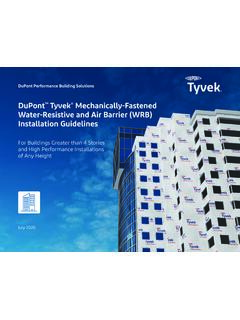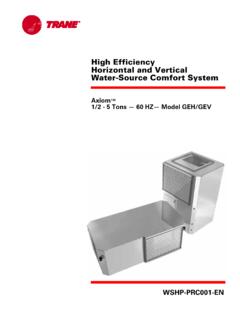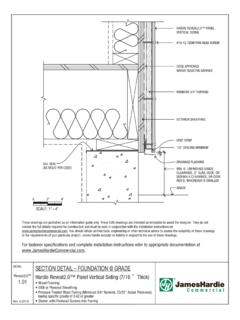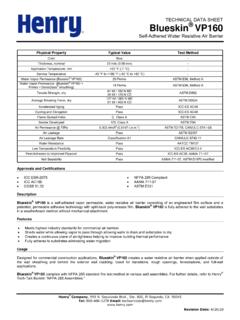Transcription of The physics of sqiling - NASA
1 The physics of sqilingBryon D. AndersonSqils ond keels, like oirplone wings, exploit Bernoulli's ond hydrodynomic insighis help designeri creqtefoster Anderson is on experimentol nucleor physicist ond,choirmon of the physics deportment ot Kent Slote University in Kent, is olso on ovocotionol soilor who lecfures ond wrifes obout the intersection behyeen physics ond addition to the recreational pleasure sailing af-fords, it involves some interesting physics . Sailing starts withthe force of the wind on the sails. Analyzing that interactionyields some results not commonly known to non-sailors. Itturns ou! for example, that downwind is not the fastest di-rection for sailing. And there are aerodynamic issues.
2 Sailsand keels work by providing "lift" from the fluid passingaround them. So optimizing keel and wing shapes involveswing resistance experienced by a moving sailboat in-cludes the effects of waves, eddiei, and turb-ulence in thewater, and of the vortices produced in air by the sails. To re-duce resistance effectively by optimizing hulls, keels, andsails, one has to understand its various powerMoving air has kinetic energy that cary through its interac-tion with the sails, be used to propel a sailboat. Like airplanewings, sails exploit Bernoulli's principle. An airplane wing isdesigned to cause the air moving over its top to move fasterthan the air moving along its undersurface.
3 That results inlower pressure above the wing than below it. The pressuredifference generates the lift provided by the is much discussion of whether the pressure differ-ence arises entirely from the Bemoulli effect or partly from thewing's impact and redirection of the air. Classic wing theoryattributes all the lift to the Bemoulli effect and ascribes the dif-ference in wind speeds above and below the wing to the wing'sasymmetric cross-sectional shape, which caused the path ontop to be longer. But it's well known that an updown sym-,metrical wing can provide lift simply by moving through theair with an upward tilf called the angle of attack. Thery de-spite the wing's symmetry, the wind still experiences a longerpath and thus greater speed over the top of the wing thanunder its bottom.
4 A NASA website has an excellent discussionof the various contributions to lift by an airplane It dis-putes the conventional simple version of wing theory and em-phasizes that lift is produced by the tuming of the fluid case is similar for sailboats. A sail is almost alwayscurved and presented to the wind at an angle of situation is shown schematically in figure 1a. Thewind moving around the "upper," or downwind, side ofthe sail is forced to take the longer path. So the presence ofthe surrounding moving air makes it move faster thanthe air passing along the "lower," or upwind, side of thesail. Measurements confirm that relative to the air pressurefar from the sail, the pressure is higher on the upwind38 February 2008 physics Todayside and lower on the downwind downwind sailing, with the sail oriented perpen-dicular to the wind directiory the pressure increase on the up-wind side is greater than the pressure decrease on the down-wind side.
5 As one turns the boat more and more into thedirection from which the wind is coming, those differencesreverse, so that with the wind perpendicular to the motion ofthe boat, the pressure decrease on the downwind side isgreater than the pressure increase on the upwind side. For aboat sailing almost directly into the wind, the pressure de-crease on the downwind side is much greater than the in-crease on the upwind with what can be done, a beginner findssome surprising results. Sailors know well that the fastestpoint of sail (the boat's direction of motion with respect to thewind direction) is not directly downwind. Sailboats movefastest when the boat is moving with the wind coming"abeam" (from the side).
6 That's easily understood: When asailboat is moving directly downwind, it can never movefaster than the wind because, at the wind speed, the sailswould feel no wind. In fact, a boat going downwind cannever attain the wind speed because there's always some re-sistance to its motion through the when the boat is moving perpendicular to the wind,the boat's speed doesn't decrease the force of the wind on thesails. One sets the sails at about 45o to the direction of mo-tion-and to the wind. The boat's equilibrium speed is de-termined by the roughly constant force of the wind in thesails and the resistance against the boat's motion through thewater. If the resistance can be made small, the velocity can belarge.
7 That's seen most dramatically for sail iceboats, whichskate on the ice with very little resistance. They can glidealong at speeds in excess of 150 kmlh with the wind abeamat speeds of only 50 km/h! Of course sailboats plowingthrough the water experience much more , some specially constructed sailboats have at-tained speeds of more than twice the wind was recognized centuries ago that a sailboat needssomething to help it move in the direction in which it'spointed rather than just drifting downwind. The answer wasthe keel. Until the development of modem wing theory itwas thought that one needed a long, deep keel to preventside-slipping. But now it's understood that a keel, like a sail,works by providing sideways lift as the water flows aroundit, as shown in figure 1a.
8 A keel must be symmetrical for@ 2008 American Institute of physics , 5-0031-9228-0802-020-6"#the sailboat to move to either side of the keel works only if the motion of the boat is not exactlyin the direction in which it's pointed. The boat must be mov-ing somewhat sideways. In that "crabbing" motion, the keelmoves through the water with an angle of attack. Just as forthe sails in the wind, that causes the water on the "high"(more downstream) side of the keel to move faster and cre-ate a lower pressure. Again, the net lift force on the keel isdue to the combination of that decreased pressure on the highside and increased pressure on the other (low) figure 1b, the keel lift thus generated points almost inthe opposite direction from the lift provided by the sails.
9 Thetwo vectors can be resolved into components along and per-pendicular to the boat's direction of motion. For a saiiboatmoving in equilibrium-that is, at constant speed in a fixeddirection-the transverse lift components from sail and keelcancel each other. The componeni of the driving force fromthe sails in the direction of motion is the force that is actuallymoving the boat forward. For equilibrium motion, that forceis balanced by the opposing component of the keel lift plusthe total resistive theory, developed over the past 100 years for flight,indicates that the most efficient wing is long and narrow. Vor-tices produced at the wing tip cost energy. A long, narrowwing maximizes the ratio of lift to vortex dissipation, thusproviding the best performance for a given wing surface also applies to sailboat sails and is now recognized that the most efficient keels are nar-row from front to back and deep.
10 Such a keel can have muchless surface area than the old long keels. Less area means lessresistance. Most modern racing sailboats, such as those usedin the America's Cup races, have deep, narrow keels that arevery efficient at providing the lift necessary to prevent side-slipping. Of course, such keels are a problem for recreationalsailors in shallow forcesA sailboat experiences several kinds of resistance. The first issimply the resistance of the hull moving through water . Asthe boat moves, it shears the water . water molecules adhereto the hull's surface. So there must be a shear-that is, a ve-locity gradient-between the adhering molecular layer at l. Forces on o moving soilboqt.








